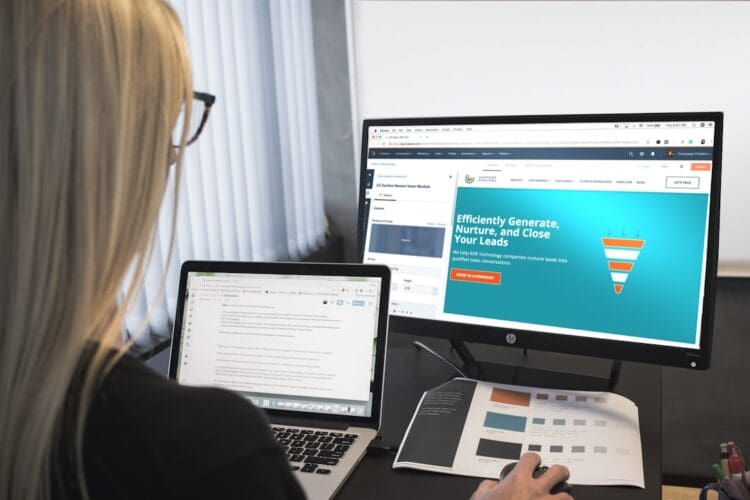
Introduction
Why is integrating SEO essential in your web design strategy? If you’re looking to enhance your online presence or boost your website’s traffic, understanding the synergy between web design SEO is pivotal. This integration is not just about aesthetics; it’s about building a foundation that search engines and users appreciate for both visibility and functionality.
- Quick Visibility Boost: Prioritize mobile-friendliness and quick load times for better search engine rankings.
- User Experience: A well-structured site appeals both to search engines for better indexing and users for navigability.
- Long-Term Growth: SEO-focused design leads to sustainable growth in site visits and user engagement.
A common misconception is that SEO is a backend tweaking process that doesn’t intersect with design. However, SEO actually dictates the structuring from the ground up—from the coding to the visual elements, ensuring that your site is not only attractive but also ranks well in search engines. This strategic approach promotes better user experiences, leading to increased interactions and conversions.
Your website is your first impression online; make it count by seamlessly blending design aesthetics with SEO practices to climb search rankings effectively and meet your business objectives efficiently.

Understanding SEO in Web Design
Your website acts as the front door to your business, welcoming potential customers. To ensure they find this door, integrating web design SEO is not just beneficial—it’s essential. Let’s break down the basics of SEO and the principles of web design that help your site not only be seen but also be effective.
SEO Basics
SEO, or Search Engine Optimization, is the art and science of making your website more visible to search engines like Google. It involves optimizing various elements of your site so that search engines can easily understand and rank it higher in search results. This includes using the right keywords, ensuring fast load times, and making your site mobile-friendly.
Web Design Principles
Effective web design is not just about looking good. It must also be functional and optimized for SEO. Here are the key principles every web designer should follow to ensure SEO-friendliness:
- Simplicity: Keep the design clean and straightforward. A clutter-free site is easier for both users and search engines to navigate.
- Consistency: Ensure that the design is consistent across all pages. This consistency helps users navigate your site more efficiently, reducing bounce rates and improving the user experience.
- Accessibility: Your site should be accessible to everyone, including those with disabilities. This not only boosts your SEO but also expands your audience reach.
- Navigation: Easy and intuitive navigation is crucial. A well-structured menu and logical page hierarchy help search engines index your content better and help users find information faster.
Integrating these design principles with SEO strategies leads to a robust website that not only attracts visitors but also keeps them engaged.
How SEO and Web Design Work Together
A well-designed website considers both aesthetics and functionality, but without SEO, even the most visually appealing site might go unnoticed. Here’s how SEO and web design should work in tandem:
-
Mobile Optimization: With the increase in mobile internet users, having a mobile-friendly website is no longer optional. Google uses mobile-friendliness as a ranking factor, so responsive design is crucial for SEO.
-
Fast Load Times: Users expect a site to load in 2 seconds or less. Slow websites have higher bounce rates and lower rankings in search results. Optimize image sizes, streamline code, and leverage browser caching to improve speed.
-
Clear Hierarchy and Navigation: A logical structure helps search engines understand your site’s content hierarchy, boosting SEO. Simple, intuitive navigation reduces user frustration and engagement drop-offs.
By merging SEO fundamentals with solid web design principles, you create a user-friendly, SEO-optimized website ready to perform well in search rankings and deliver a positive user experience. This strategic blend not only enhances visibility but also drives traffic and fosters business growth, ensuring your online presence is both seen and felt.
Let’s delve deeper into the key elements of SEO-friendly web design, ensuring your site is not only attractive but also ranks well in search engines. This strategic approach promotes better user experiences, leading to increased interactions and conversions.
Key Elements of SEO-Friendly Web Design
To ensure your website not only looks good but also performs well in search engine rankings, it’s crucial to integrate specific SEO-friendly elements during the design process. Here, we’ll explore the essential components that make a web design SEO-effective.
Mobile-First Design
Google prioritizes mobile-friendly websites when indexing and ranking pages. With over 60% of searches coming from mobile devices, a mobile-first approach is not just beneficial—it’s essential. The recommended strategy is responsive design, where the layout adjusts based on the device’s screen size, ensuring a seamless experience for all users.
- Short paragraphs and adequate white space enhance readability on small screens.
- Pop-ups should be minimized as they can frustrate mobile users and lead to higher bounce rates.
- Use appropriate font sizes (minimum 16px) and mobile-optimized meta tags to improve usability and SEO.
Website Speed
Fast-loading pages provide a better user experience and are favored by search engines. Page speed is a direct ranking factor, influencing both user engagement and search engine visibility.
- Optimize image sizes and formats, considering modern formats like WebP, which can reduce file sizes significantly.
- Reduce HTTP requests by minimizing the number of elements that need to load.
- Enable browser caching to speed up load times for repeat visitors.
Tools like Google’s PageSpeed Insights can help you analyze and optimize your website’s speed by providing actionable recommendations.
Website Structure
A well-organized website structure helps search engines and users navigate your site more effectively.
- Use a logical hierarchy in your site architecture, with clear categories and subcategories.
- Ensure that each page is accessible through intuitive navigation, enhancing both the user experience and the site’s crawlability.
Navigation and Internal Links
Effective navigation and strategic internal linking are crucial for SEO and usability.
- Clearly labeled navigation menus guide users through your site, reducing bounce rates and increasing engagement.
- Internal links should connect relevant content, helping search engines understand the context and relationship between different pages on your site.
Indexability and Crawlability
For a website to rank well, it must be easily indexable and crawlable by search engines.
- Ensure main content is in HTML text format, as this is easiest for search engines to parse.
- Avoid technologies like Flash, which are difficult for search engines to read.
- Use clean, simple URLs and ensure that your site’s robots.txt file facilitates rather than hinders search engine access.
Implementing these key elements in your web design not only improves your site’s aesthetic appeal but also boosts its performance in search rankings. By focusing on mobile-first design, website speed, structured website architecture, intuitive navigation, and ensuring indexability and crawlability, you create a robust foundation for your SEO efforts.
Moving forward, we will address common web design mistakes that can negatively impact your SEO and how to avoid them, ensuring your site remains optimized and competitive.
Common Web Design Mistakes That Hurt SEO
When crafting a website, it’s crucial to avoid certain pitfalls that can negatively affect your search engine optimization (SEO) and overall site performance. Here are some common errors to watch out for:
Flash and JavaScript
Using Flash and excessive JavaScript can be detrimental to your website’s SEO. Search engines like Google struggle to read content embedded in these formats, which can hinder your site’s visibility. For instance, critical content placed inside a Flash element might not be indexed at all by search engines.
Tip: Limit the use of Flash and complex JavaScript, or replace them with HTML5 and CSS3, which are more SEO-friendly technologies.
Poor Readability
The readability of your website impacts user experience and SEO. Tiny fonts, poor color contrasts, and cluttered layouts can drive visitors away and increase bounce rates, which search engines use as a signal for poor quality.
Tip: Use legible font sizes and contrasting colors to enhance readability. Keep your layout clean and user-friendly.
Non-Responsive Design
In today’s mobile-first world, having a non-responsive website can significantly harm your SEO. Google and other search engines prioritize mobile-friendly websites in their rankings.
Tip: Implement responsive web design to ensure your site looks and works well on all devices, from desktops to smartphones.
Ignoring Content and Images
Content is king in SEO. A visually appealing website won’t rank well if the content isn’t valuable and relevant. Furthermore, images need to be optimized for fast loading times and should include alt text for search engines to index.
Tip: Regularly update your site with high-quality content and optimize all images with appropriate file sizes and descriptive alt tags.
Slow Page Speed
A slow-loading website provides a poor user experience and is penalized by search engines in the rankings. Even a 100-millisecond delay in load time can decrease conversions by 7%.
Tip: Optimize your website’s speed by compressing images, minifying CSS and JavaScript files, and leveraging browser caching.
By addressing these common mistakes in your web design, you can enhance both the user experience and your site’s SEO performance. This proactive approach ensures your website not only attracts visitors but also retains them, boosting your overall online presence. Moving forward, let’s explore effective strategies to further optimize your web design for SEO.
How to Optimize Your Website Design for SEO
Optimizing your website design for web design SEO isn’t just about making it look good; it’s about making it work efficiently for both users and search engines. Here’s how you can ensure your website design is optimized for SEO:
Code Optimization
To ensure your website runs smoothly and quickly, clean and efficient code is crucial. This involves:
- Minifying CSS, JavaScript, and HTML: This reduces file sizes by removing unnecessary spaces, comments, and characters.
- Using CSS3 and HTML5: These technologies allow for lighter and faster loading of pages compared to older code.
- Avoiding Inline Styles: Use external stylesheets since they reduce page clutter and help in caching styles for multiple pages, which speeds up loading times.
Mobile-Friendliness
With Google’s mobile-first indexing, your site must perform well on mobile devices. To achieve this:
- Responsive Design: Ensure your site adjusts seamlessly to fit different screen sizes and resolutions. Google recommends this approach as it makes content accessible and improves user experience across devices.
- Viewport Configuration: Set the viewport using the meta viewport tag to control layout on mobile browsers.
- Touchscreen Readiness: Make sure buttons and links are easy to tap to enhance navigation on touch devices.
Readability Enhancement
Content must be easy to read and engage with:
- Font Size and Type: Use a minimum of 16px for body text and stick to easy-to-read fonts.
- Contrast: Ensure high contrast between text and background colors to make reading easier on the eyes.
- Content Layout: Use headings, bullet points, and short paragraphs to break up text and make the page skimmable.
Optimizing File Names and Sizes
Images can slow down your site if not optimized:
- Descriptive File Names: Rename files with relevant keywords (e.g.,
black-ford-bronco.jpginstead ofimage1.jpg). - Compression: Use tools to compress images without losing quality. Formats like JPEG 2000, JPEG XR, and WebP often provide better compression than traditional JPEG or PNG.
- Proper Sizing: Resize images to the display size on your site to reduce unnecessary file size.
Alt Tags for Images
Alt tags help search engines understand what an image is about, which can boost your site’s SEO:
- Descriptive and Concise: Include alt tags that concisely describe the image, using keywords appropriately.
- Context Matters: Ensure the alt text provides context to the image as it relates to the content of the page.
Simplified URL Structure
A clear URL structure helps search engines and users understand the layout of your website:
- Keyword-Rich URLs: Include relevant keywords in your URLs. For example,
www.example.com/services/seo-auditstells both users and search engines about the page content. - Hyphens Over Underscores: Use hyphens to separate words in URLs, as underscores are not recognized by search engines as space.
- Avoid Complex URLs: Keep URLs short and avoid using unnecessary parameters or numeric codes.
By implementing these strategies, you can significantly enhance your site’s SEO through thoughtful web design. Not only will these efforts improve search engine visibility, but they will also offer a better user experience, which is key to retaining visitors and converting them into customers. Moving on, let’s delve into how enhancing user experience can lead to better SEO outcomes.
Enhancing User Experience for Better SEO Outcomes
Enhancing the user experience (UX) on your website is crucial for both keeping your audience engaged and improving your SEO rankings. Here’s how you can optimize the UX to achieve better SEO outcomes.
Quality Visuals
Visual appeal matters. Websites that use high-quality images and thoughtful design layouts tend to keep visitors on the page longer, which can signal to search engines that your site offers valuable content. Remember to:
- Use images that are relevant and add value to the content.
- Ensure graphics are high resolution yet optimized for fast loading.
- Align visual elements with your brand for consistent user experience.
Content Focus
Content is king in SEO, but the way it’s presented can make or break your website’s effectiveness. To optimize content for both users and search engines:
- Write clear, concise, and informative content that addresses your audience’s needs.
- Use headings and subheadings to organize content and make it easy to scan.
- Include keywords naturally to help improve your site’s visibility in search results.
Responsive Design
With a variety of devices used to access the internet, responsive design has become a cornerstone of effective web design. A responsive website automatically adjusts to fit the device it’s being viewed on, which enhances user experience and supports SEO. Google rewards mobile-friendly websites with higher rankings in search results. Testing your site’s mobile-friendliness can be easily done with tools like Google’s Mobile-Friendly Test.
Speed Optimization
Website speed is a critical factor for both user satisfaction and SEO. A slow-loading site can frustrate users and increase bounce rates, negatively impacting your SEO. To keep your site speedy:
- Compress images and videos to reduce their file size without losing quality.
- Minimize the use of heavy scripts and plugins.
- Use website caching to improve page load times for returning visitors.
By focusing on these key areas—quality visuals, content focus, responsive design, and speed optimization—you can enhance the user experience on your site. This not only keeps visitors happy but also improves your site’s SEO performance, leading to better visibility and higher rankings in search results. Moving forward, let’s address some common questions about web design SEO to clarify any doubts and provide further guidance.
Frequently Asked Questions about Web Design SEO
What is the impact of web design on SEO?
Web design plays a critical role in SEO by affecting how search engines crawl and index a website. A well-designed website helps ensure that search engines can easily understand and categorize the content, which can boost your rankings in search results. Key design elements that impact SEO include:
- Structure and Navigation: Clear structure helps search engines understand your site’s layout and the relationships between different content pieces.
- Mobile-Friendliness: With Google’s mobile-first indexing, having a responsive design is crucial.
- Load Time: Fast-loading pages are favored by search engines and improve overall user experience.
- Accessibility: Proper use of HTML tags, readable fonts, and contrast ensures content is accessible to all users, including those with disabilities, which can positively influence SEO.
How does mobile-friendliness affect SEO?
Mobile-friendliness is now a cornerstone of SEO. Since Google introduced mobile-first indexing, the mobile version of your website is considered the primary version. If your site isn’t optimized for mobile devices, it might not rank well. Here are key reasons why mobile-friendliness is essential:
- User Experience: A majority of web traffic comes from mobile devices. A site that performs well on mobile provides a better user experience, leading to longer visit durations and lower bounce rates.
- Google’s Mobile-First Indexing: Google predominantly uses the mobile version of the content for indexing and ranking. A non-mobile-friendly site could see a significant drop in rankings.
- Local SEO: Mobile-friendliness improves local search results, which is crucial for businesses targeting local customers.
Why is website speed crucial for SEO?
Website speed is a direct ranking factor for Google’s search algorithms. Faster websites provide a better user experience, keeping users engaged and reducing bounce rates. Here’s why speed is pivotal:
- User Retention: Slow-loading websites lead to high bounce rates as users tend to leave a site if it doesn’t load quickly.
- Conversion Rates: Speed improvements directly correlate with conversion rates. Even a 100-millisecond delay can decrease conversions by 7%.
- SEO Ranking: Google has explicitly mentioned page speed as a ranking factor in their algorithm updates. Faster sites are likely to rank higher than their slower counterparts.
By ensuring your website is well-designed, mobile-friendly, and fast-loading, you can significantly enhance your SEO efforts. These factors not only help improve your site’s usability and user engagement but also bolster your rankings in search engine results. Moving forward, we will continue to explore other essential aspects of web design SEO to optimize your online presence effectively.
Conclusion
At OneStop Northwest, we understand the intricate relationship between web design and SEO. Our approach ensures that your website not only looks appealing but also performs excellently in search engine rankings. By integrating SEO principles right from the design phase, we help you build a digital presence that is not just visually engaging but also optimized for search engines.
Web design SEO is not a one-time task but a continuous process of improvement and adaptation. As search engines evolve, so too must our strategies and techniques. This means regularly updating the design and content of your website to meet the latest SEO standards and user expectations. Our commitment is to provide you with a website that grows with your business, adapting to changes in the digital landscape and continually enhancing its visibility and user engagement.
We’ve explored several key aspects of SEO-friendly web design, including mobile responsiveness, page speed, and user-friendly navigation. These elements are crucial for not only attracting visitors but also converting them into customers. By focusing on both aesthetics and functionality, we ensure that your website serves as a powerful tool for business growth.
A successful SEO strategy involves more than just technical adjustments; it requires a holistic approach that encompasses great design, quality content, and an outstanding user experience. At OneStop Northwest, we excel in creating websites that not only meet but exceed these criteria.
Ready to elevate your online presence? Visit our SEO services page to learn more and get started with us today. Let us help you navigate the complexities of web design SEO and ensure your website not only looks great but also ranks well in search engines and delivers a fantastic user experience. Together, we can achieve remarkable results and drive your business forward in the digital world.




